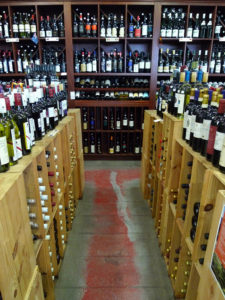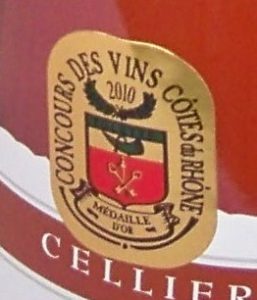Over the years, number of wine competitions and wine awards in existence have skyrocketed. Years ago, there might have been a handful of competitions, while nowadays, it’s impossible to keep track of how many there are. It seems everyone and their mother has hosted a wine competition, and all it takes to win a medal is to show up and don’t make the judges retch.
When attempting to select wine, many studies have examined the effect of extrinsic cues (i.e. brand, vintage, grape(s), country of origin, other label information) on wine selection and purchase, with wine awards included. Some have found that wine awards are relatively low in importance, while others found them much more important when it comes down to wine purchase selection.

Photo courtesy Flickr user Ben Tsai
Are displaying wine awards on a bottle of wine effective in getting people to purchase the wine? The answer, according to a new study published in the Journal of Retailing and Consumer Services, is somewhat complicated.
Brief Methods
A group from the University of Otago (NZ) performed a qualitative study using focus groups to gain a better understanding of how consumers perceive wine awards on a bottle, and how these awards influence their purchase decisions in the store.
4 focus groups took place (1.5hrs each) between November 2011-June 2012 in Dunedin, NZ. The primary researcher moderated the discussions, and used the same questions as a guide to get through each session.
44 people participated in this study (50% women). Participants completed questionnaires to determine their involvement or familiarization with wine, as well as socio-demographics. Participants were placed in specific focus groups based upon their answers to the wine involvement questionnaire.
Within each focus group, there was a mix of participants self-reporting as experts, high involvement consumers, medium involvement consumers, low involvement consumers, and wine beginners. Not all categories were represented in every focus group.
During the focus groups, questioning started with an “ice-breaker” to encourage participation, then the conversations continued based upon questions related to general food and beverage awards in New Zealand, participants’ use of wine awards when making a purchase decision, and participants’ general awareness of how many wine awards there are.
Selected Results
- Three themes emerged from the focus groups:
- A sense of skepticism from the considerable number of wine awards.
- Concern over confusing and sometimes misleading nature of wine awards.
- Concern over lack of transparency in wine awards.
- Regarding the skepticism of the large number of wine awards:
- Participants mentioned they often see more wine bottles with wine award stickers than without.
- Some thought the wine award stickers were present just to make the bottles “look prettier”.
- Those with higher levels of involvement said that in the past, a wine award would have meant the wine was high quality, but now the presence of a wine award sticker on the bottle could mean nothing at all.
Quoting a medium-involvement consumer:
“Ten years ago, I would go into the supermarket and see a bottle with an award and think that has an award and that must be good. Whereas now, I’m a bit more cynical around those labels I have to say…yes, it is my growing knowledge that allows me to be more cynical.”
- Some participants said they don’t trust a wine award on a bottle because of “lack of awareness” of the award.
-

Photo courtesy Flickr user Ruth Hartnup
Regarding the concern over “confusing or misleading nature” of wine awards:
- Participants mentioned they often see a wine award on the bottle, and buy it without paying attention to what the award was for. Then, when they got home, they realized it was something meaningless and felt misled.
Quoting a high-involvement consumer:
“The bottle had a trophy sticker but by reading the label it said that it was the best wine with pizza award.”
- Other participants were confused over the nature of an award.
- Regarding the concern over the lack of transparency in wine awards:
- Some participants said knowing the judges might help them interpret the results.
- Some high- and medium-involvement consumers said there wasn’t enough information present regarding criteria they used for assigning awards to a given wine.
- This concern was greater when a more expensive bottle was being considered.
- Wine beginners showed no interest in the judging process or how wine awards were handed out.
- How wine awards were used by consumers in the decision-making process:
- Despite all concerns and criticisms of wine awards made by the focus group participants, all of them said that they do use wine awards in their decision-making process. HOW they used them differed between involvement levels.
- High-involvement consumers tended to consider only more prestigious wine awards in their purchase decision process.
- Most medium-involvement consumers, some low-involvement consumers, and all wine beginners tended to use wine awards as a guide to help them select a wine they didn’t know anything about or a special occasion wine.
- Some low-involvement consumers and all wine beginners tended to be drawn to a wine award because the sticker made the bottle “look nice”.
- Some medium- and low-involvement consumers used wine awards when choosing a wine that was on sale or was in a cheaper price range.
Quoting a medium-involvement consumer:
“I put more focus on the price at the moment, but if there are two wines in similar prices and one has got an award, I will be more tempted to go for the awards, but if it costs more, I wouldn’t.”
- Some medium- and low-involvement consumers used wine awards when choosing a wine as a gift.
- Low-involvement consumers and wine beginners were not willing to pay more for a wine with an award, as they claimed these wines were too expensive to begin with.
- Some medium-involvement consumers said they would be willing to pay more for a wine with an award, as to them, the award indicated higher quality.
- High- and medium-involvement consumers were more selective in the wine awards they considered for their purchase, with more prestigious awards being more influential.
- Gold medals were more influential than silver or bronze for all involvement levels.
- Silver and bronze medals were viewed with caution.
Quoting a medium-involvement consumer:
“Now, I see a bronze for ‘that’s what they got for turning up’…everybody who entered gets bronze.”
Conclusions
This study suggests that while there is skepticism over putting wine awards on a bottle, everybody uses them in some way to make a decision in the wine purchasing process. However, exactly how these awards are used to influence their wine purchase decisions differ depending upon an individual’s experience with wine.
The more experienced the consumer, the more likely they are to consider only the most prestigious wine awards, and ignore all other awards. All consumers tended to think that anything less than gold was suspicious, and that a silver or bronze medal doesn’t provide any useful information regarding the quality of the wine in that bottle.

Photo By Véronique PAGNIER (Own work) [Public domain], via Wikimedia Commons
Regarding the concern over “confusing or misleading nature” of wine awards, I have to say some of this is the consumers’ fault. Too lazy to read the label in the store? Not the wineries’ fault that you felt “cheated” after learning the award was because your wine won the award for the best wine for pizza. Is this a little slimy on the part of the winery? Sure, but I think the blame can be spread out a bit here.
There are times, that weren’t mentioned in study, when retailers might include award information in the description card for a wine from a different vintage year than the one they are currently selling, which is certainly misleading (and might even been illegal?). Again, the consumer should stop to read the fine print here, but it’s certainly a smarmy move on the part of the retailer and I would strongly advise against doing that if the retailer wishes to establish trust with their patrons.
Regarding the concern over the lack of transparency in wine awards, the researchers suggested that based upon the results of this study, greater transparency about the wine award and the competition itself might help improve the chances of purchase from those in the more wine educated groups. Of course, if your target market is beginners or low-involvement consumers, then this information would be unnecessary.
While most consumers expressed concern or skepticism over wine awards, they all use them in some way to aid their purchase decisions. Depending upon the consumer and their level of wine involvement a winery intends to target with their wine, this study suggests that there are different ways to approach presenting wine awards on bottles that will help improve the chances of selling that bottle.
Source:
Neuninger, R., Mather, D., and Duncan, T. 2017. Consumer’s scepticism of wine awards: A study of consumers’ use of wine awards. Journal of Retailing and Consumer Services 35: 98-105.

5 comments for “Putting Wine Awards on The Bottle: A Study on Consumer Purchase Behavior”